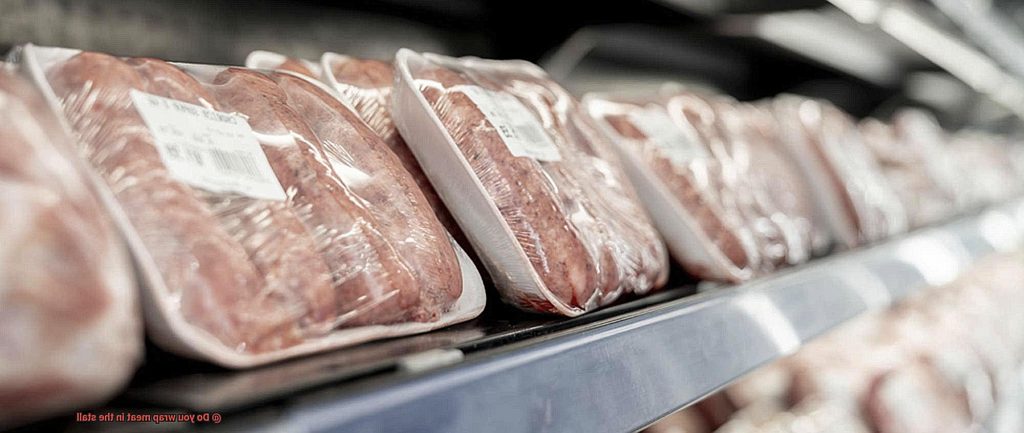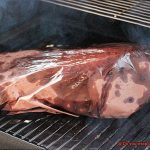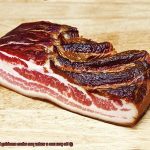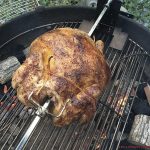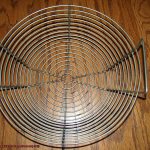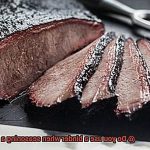Are you a true meat aficionado always chasing that perfect barbecue experience? Then you’ve probably found yourself wondering, “Do you wrap meat in the stall?” This question has sparked endless debates in the world of barbecuing. Some experts will argue that wrapping meat during cooking is cheating and can ruin the texture and flavor. While others swear by it as the secret to achieving mouth-watering barbecue.
The “stall” is a common occurrence when smoking large cuts of meat such as brisket or pork shoulder. It’s when the internal temperature stops rising, causing the meat to plateau for hours on end, leading to dryness and toughening.
But should you wrap your meat during this stall? Wrapping meat involves tightly packing it in aluminum foil or butcher paper to lock in moisture while cooking. This technique is known as the Texas Crutch and has gained popularity over time. By wrapping your meat during the stall, you can preserve its juices, speed up cooking time, and soften its exterior.
In this article, we’ll delve deep into this debate and weigh up the pros and cons of wrapping meat during the stall. So grab a cold one, put on your apron, and let’s fire up that grill.
Contents
Pros of Wrapping Meat in the Stall
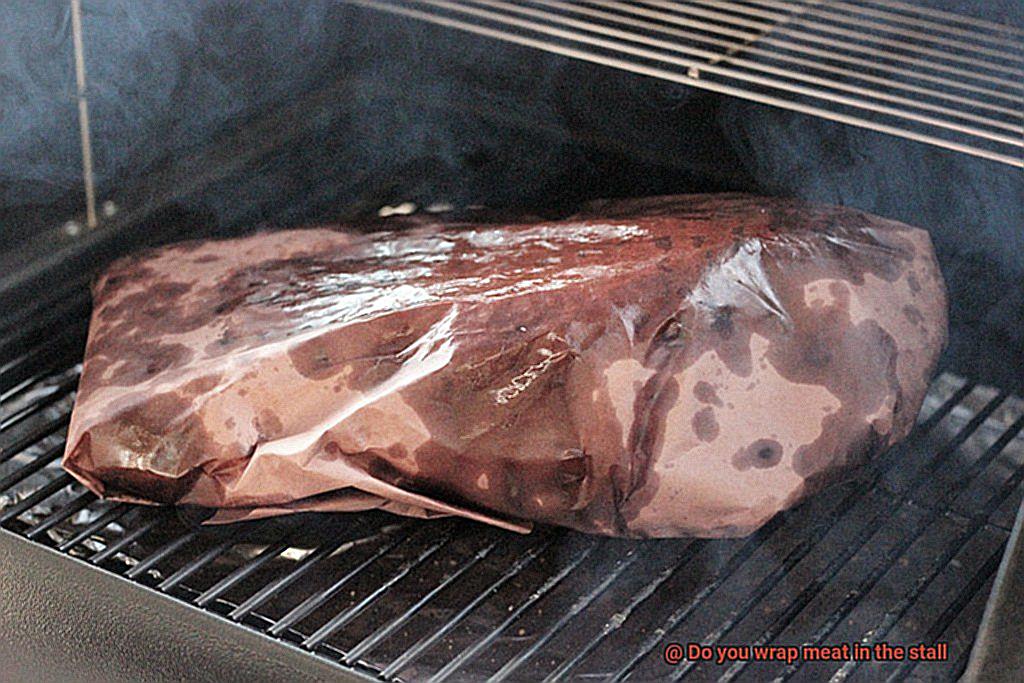
The stall is a frustrating stage during cooking where the meat’s internal temperature plateaus or even drops. Wrapping meat in foil or butcher paper during this time can help push through the stall and result in a more tender and juicy final product.
One of the most significant advantages of wrapping meat in the stall is that it helps retain moisture. When exposed to high heat, meat can lose moisture quickly, resulting in tough and dry meat. Wrapping the meat creates a barrier that traps moisture inside, leading to a juicier finished product.
In addition to retaining moisture, wrapping meat in the stall can also speed up cooking times. Extended stalls can prolong the cooking process, causing frustration and delaying meal times. By wrapping the meat, a more controlled environment is created, helping push through the stall.
Notably, wrapping meat in the stall can add flavor to your final product. By wrapping the meat in foil or butcher paper, you create an opportunity for juices and flavors to mingle together. This results in a more complex and flavorful final product that will leave your taste buds dancing with delight.
However, some experts argue against wrapping meat in the stall. They believe that wrapping can limit the smoke flavor absorbed by the meat and soften its bark, making it difficult to achieve a crispy crust.
Cons of Wrapping Meat in the Stall
While this technique can have its advantages, it’s important to weigh the pros and cons before deciding if it’s the right fit for your grilling needs.
The “stall” refers to a period during cooking when meat reaches a certain temperature and stops cooking. Wrapping the meat in aluminum foil or butcher paper can help push past the stall and speed up the cooking process. However, wrapping meat in the stall also comes with some drawbacks.
Firstly, one of the biggest cons of wrapping meat in the stall is that it can result in a softer crust or bark on the outside of the meat. The trapped moisture inside the wrap creates steam, which can soften the exterior of the meat. This can be particularly problematic for meats like brisket or pork shoulder, which rely on a crispy crust for texture and flavor.
Another disadvantage of wrapping meat in the stall is that it can impact smoke flavor. When the meat is wrapped, it is no longer exposed to smoke, which can lead to a less smoky flavor profile. For those who prioritize smoky flavor in their meats, this can be a major drawback.
Additionally, wrapping meat in the stall can sometimes result in overcooking. While wrapping can help push through the stall and speed up cooking time, it can also cause the internal temperature of the meat to rise more quickly than desired. This can lead to overcooked, dry meat.
Lastly, wrapping meat in the stall can be messy and time-consuming. Wrapping requires additional materials like aluminum foil or butcher paper and can create a mess when juices leak out during the wrapping process. It also adds an extra step to the cooking process, which may not be desirable for those looking for a simpler grilling experience.
Different Ways to Wrap Meat in the Stall
If you’re a meat enthusiast who loves to grill or smoke, you know that the stall can be a frustrating experience. But don’t despair, there are ways to prevent your meat from drying out during this period. One of the most effective methods is wrapping your meat in foil or butcher paper. Let’s take a closer look at the benefits and drawbacks of each method.
- Foil: Foil is a fantastic option if you want to retain as much moisture as possible. It creates a tight seal around the meat, locking in the juices and preventing them from evaporating. However, foil may limit the amount of smoke flavor that is absorbed by the meat, resulting in a less smoky taste. Additionally, it can create a steaming effect that softens the bark – the outer layer of the meat – which may not be desirable for some.
- Butcher Paper: Butcher paper allows for some air circulation, which can help create a crispy bark on the outside of the meat. It’s also more heat-resistant than foil, making it an excellent choice for longer smoking times. However, it doesn’t create as tight of a seal as foil, so it may not retain as much moisture. If you prefer a tender and juicy end product, butcher paper may not be the best option.
- Texas Crutch Method: Some grillers prefer to use a combination of foil and butcher paper, known as the “Texas crutch” method. This involves wrapping the meat tightly in foil first, then wrapping it again in butcher paper. This method can help retain moisture while still allowing for some air circulation. If you’re looking for the best of both worlds – a crispy bark and juicy meat – this method may be worth trying.
- No Wrap Method: Another option is to not wrap your meat at all during the stall. This requires more attention and monitoring, but can result in a crispy bark on the outside of the meat. To keep the meat moist, you’ll need to spritz it frequently with a liquid, such as apple juice or vinegar. This method is ideal for those who want to maximize the smoky flavor of their meat.
- Peach or Apple Leaves: Finally, some pitmasters swear by using peach or apple leaves to wrap their meat in the stall. These leaves provide a sweet and fruity flavor, as well as help to keep the meat moist. If you’re looking for a unique and flavorful twist on your smoked meat, give this method a try.
Tips for Wrapping Meat in the Stall
Here are some reasons why you should pay attention to this crucial step:
- Retains Moisture – The stall is a critical period during which the internal temperature of the meat plateaus and moisture begins to evaporate. Wrapping your meat in foil, butcher paper, or other materials helps to trap this moisture inside the meat, preventing it from drying out and becoming tough.
- Adds Flavor – Wrapping your meat in the stall allows you to add extra flavor to your meat. You can experiment with different marinades, seasonings, or even liquids like apple juice or beef broth to enhance the taste of your dish.
- Improves Cooking Time – By retaining moisture, proper wrapping can help your meat cook faster and more evenly. This can be especially helpful for larger cuts of meat that require longer cooking times.
- Prevents Smoke Loss – Some people worry that wrapping their meat during smoking will limit the amount of smoky flavor that gets absorbed. However, if you wrap your meat properly, you can protect it from smoke loss and still achieve a delicious smoky taste.
- Creates a Crispy Crust – While some may argue that wrapping your meat can make it difficult to achieve a crispy crust, proper wrapping techniques can actually help create a delicious outer layer on your meat. For example, wrapping in foil can help create a nice bark while keeping the inside moist.
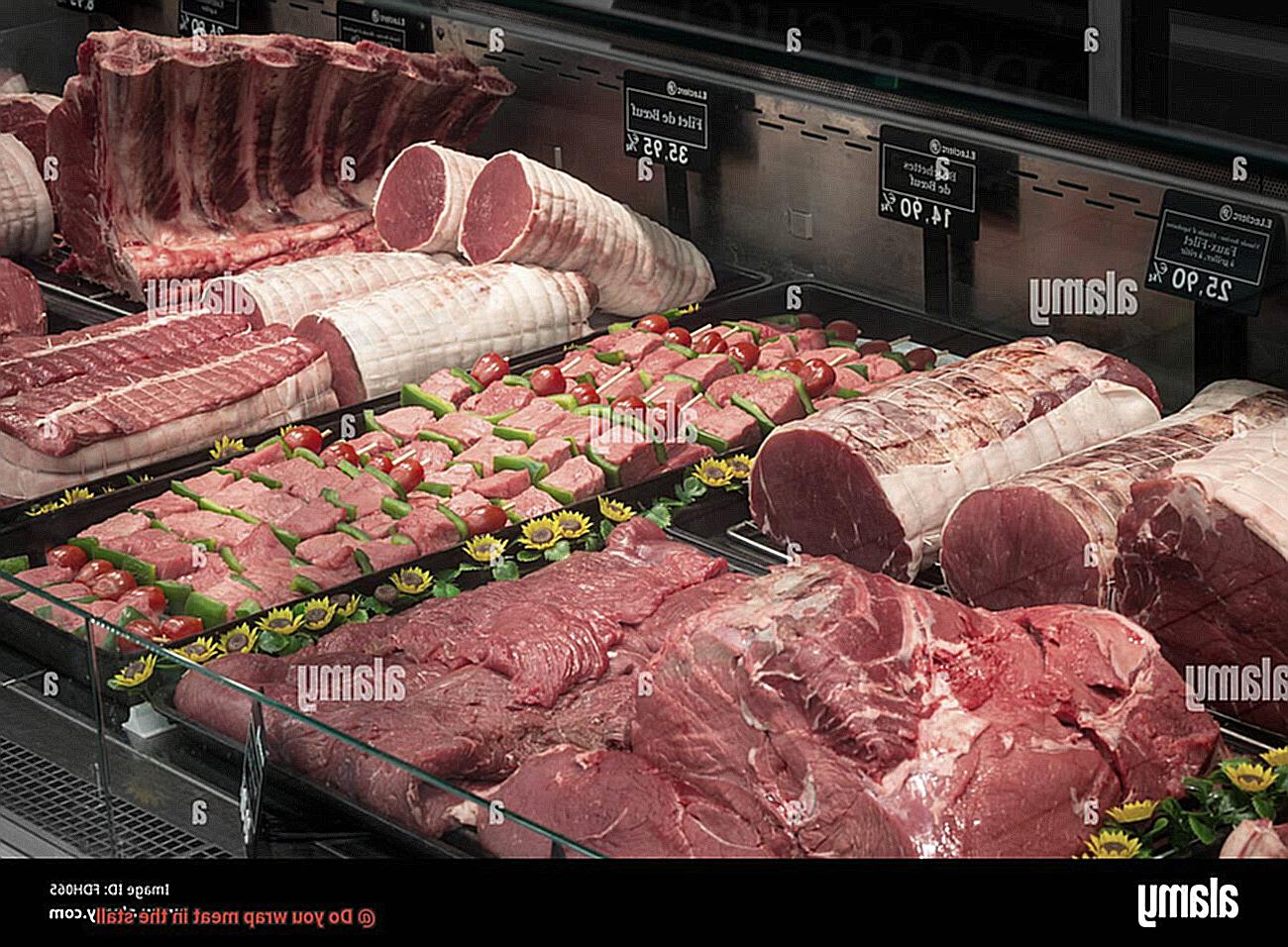
When it comes to wrapping meat in the stall, timing is key. Wait until the internal temperature of the meat reaches around 150-160°F before wrapping to ensure that you get a nice smoky flavor. Choose a sturdy material like heavy-duty foil or butcher paper and wrap the meat tightly to prevent any air from escaping. Adding a small amount of liquid like apple juice or beef broth can help create steam and keep the meat moist. Finally, monitor the internal temperature of the meat while it’s wrapped to avoid overcooking or drying out.
How to Avoid Drying Out Your Meat When Not Wrapping in the Stall
When it comes to smoking meat, there’s always a debate about whether or not to wrap meat in the stall. While wrapping can help keep your meat moist and speed up cooking time, some pitmasters prefer not to wrap their meat for a better smoky flavor and bark.
However, if you choose not to wrap your meat, there are some techniques you can use to prevent it from drying out.
Consistent Temperature Control
One of the most important things when smoking meat without wrapping is to maintain consistent temperature control. Fluctuations in temperature can cause the meat to dry out, so it’s essential to use a good quality smoker with reliable temperature control. By keeping the smoker at a constant temperature, you can ensure that your meat cooks evenly and stays moist.
Use a Water Pan
Using a water pan in your smoker is another way to keep your meat from drying out. The water will help create humidity inside the smoker, which can prevent the meat from drying out. Additionally, the steam from the water will add moisture back into your meat, keeping it juicy and tender.
Spritzing with Liquid
Spritzing your meat with apple juice or another flavorful liquid every hour or so will keep it moist and add flavor. By spritzing your meat every 30 minutes or so, you’re adding moisture back into the meat and creating a barrier that prevents it from drying out. This technique also adds flavor and enhances the overall taste of your smoked meats.
Use a Dry Rub
A dry rub that contains salt is an effective way to prevent your meat from drying out when not wrapped in the stall. Salt helps to retain moisture in the meat and prevents it from drying out. Make sure to apply the rub liberally and evenly over the entire surface of the meat for maximum effectiveness.
Rest Your Meat
Once your meat reaches its desired internal temperature, remove it from the smoker and let it rest for at least 10-15 minutes before slicing. This allows the juices to redistribute throughout the meat, making it more tender and juicy. Resting your meat is an essential step in smoking, whether you wrap your meat in the stall or not.
The Benefits of Not Wrapping Meat in the Stall
While some swear by wrapping meat in foil or butcher paper during the stall, I’m here to tell you that leaving your meat unwrapped can lead to fantastic results.
For starters, one of the most significant benefits of not wrapping your meat during the stall is achieving a mouthwatering bark. The flavorful crust that forms on the outside of your meat is what makes it stand out, and wrapping it can soften and reduce the texture. On the other hand, leaving it unwrapped allows for a firmer bark texture and a more concentrated flavor.
But wait, there’s more. Leaving your meat unwrapped can also result in a juicier finished product. Wrapping traps moisture inside, leading to a steamy environment that can overcook and dry out your meat. By leaving it unwrapped, moisture is given an opportunity to evaporate naturally, keeping your meat juicy and packed with flavor. Plus, more smoke flavor can penetrate the meat, creating a more complex taste.
Lastly, not wrapping your meat during the stall can save you precious time in the cooking process. Wrapping slows down heat transfer and extends cooking time unnecessarily. By leaving it unwrapped, you can cook your meat faster without sacrificing quality.
How to Achieve a Crispy, Caramelized Crust on Your Meat Without Wrapping
Achieving a crispy, caramelized crust on meat is the ultimate goal for any grill master. However, not everyone wants to wrap their meat in the stall to achieve this result. If you’re one of those grillers, follow these tips to achieve a perfect crust without wrapping.
Preheat your grill to high heat
The first step is to preheat your grill to high heat. This will help create the charred exterior that’s necessary for a crispy crust. Keep the lid closed as much as possible to maintain the heat.
Apply a dry rub
Next, apply a dry rub generously on your meat. Dry rubs consist of a mixture of herbs, spices, and sugars that can add flavor and create a flavorful crust. Allow the rub to sit on the meat for at least 30 minutes to allow the flavors to penetrate.
Check for grill marks
After a few minutes, check for grill marks on the meat. Once grill marks form, rotate the meat 90 degrees to create crosshatch marks. If there are no grill marks yet, continue cooking until they form.
Flip the meat over
Once grill marks have formed, flip the meat over and repeat the process on the other side. Continue cooking until your desired level of doneness is reached.
Baste with a sauce or glaze
Basting with a sauce or glaze can add flavor and help create a sticky surface that will further enhance the crust. Brush on the sauce or glaze every few minutes until the meat is fully cooked and has reached your desired level of doneness.
P3uxKyshonE” >
Conclusion
To wrap or not to wrap, that is the question when it comes to meat in the stall. This age-old debate has raged on for years, with some claiming that wrapping can hinder smoke flavor and bark texture, while others swear by it as a means of preserving moisture, speeding up cook time, and enhancing overall flavor. Ultimately, the decision rests with personal preference.
If you do choose to wrap your meat during the stall phase, there are several methods to consider. You can use foil or butcher paper, try the Texas Crutch technique, or even experiment with peach or apple leaves. However, be sure to keep an eye on internal temperature while wrapped to prevent overcooking or drying out.
On the other hand, if you prefer unwrapped meat during the stall phase, there are ways to ensure your meat remains juicy and tender. Maintaining consistent temperature control, using a water pan for added humidity, spritzing with liquid for moisture retention and applying a dry rub are all effective techniques.
Regardless of whether you choose to wrap your meat or not during the stall phase, achieving a crispy crust is possible through preheating your grill on high heat before grilling your meat and checking for grill marks.
In conclusion, whether you’re a seasoned pitmaster or just starting out with grilling meats at home – experimenting with different techniques will help you discover what works best for you.

